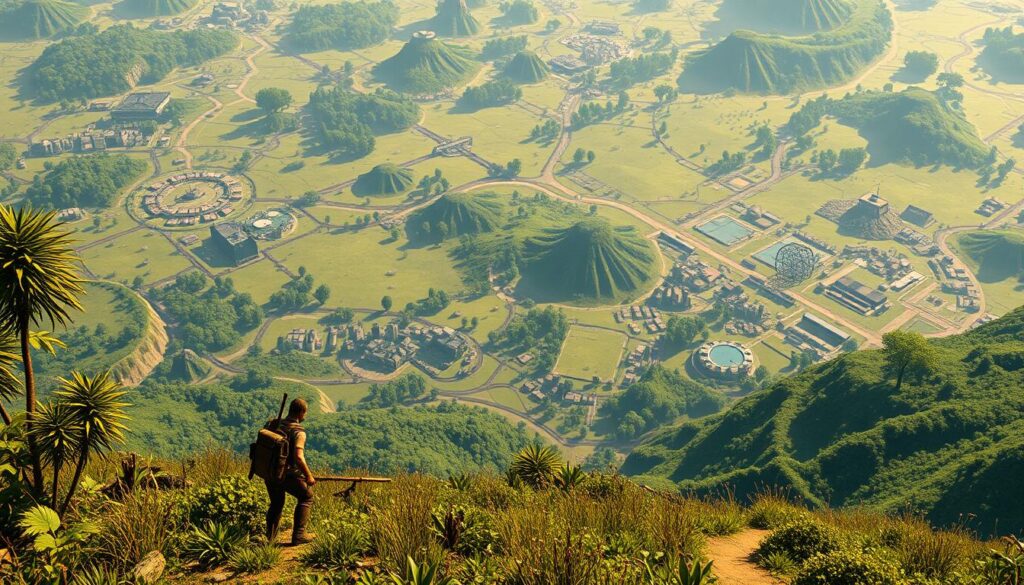Imagine if the secret to amazing gameplay wasn’t just about stories or looks. It could be how resources are balanced in dynamic worlds. In Android game making, balancing resources is key to keeping players hooked and moving the story forward. By using procedural generation, developers can create huge, engaging worlds. These worlds draw players in while making sure resources are used wisely.
This talk highlights the role of resource management in Metaverse game design. It shows how it affects user experiences and makes games more interactive.
Introduction to Resource Balancing in Dynamic Procedural Worlds
Resource balancing is key to a great gaming experience in dynamic procedural worlds. For Android games, it means managing resources well. This makes the game more fun and engaging.
It’s all about finding the right balance. Players need fair resources, but the game must stay exciting. Developers use many strategies to make this happen. It affects how much fun a player has.

Understanding Procedural Generation Techniques
Procedural generation is a game-changing method in game making. It uses algorithms to create content on the fly. This approach makes games more unique and exciting for players.
By using procedural generation, developers can make sure each game session is different. This means players always find something new and fun to do. It’s like discovering a new world every time you play.
Overview of Procedural Generation
Procedural generation uses algorithms to make content automatically. It’s not made by hand. One key tool is Perlin noise, which makes terrains look real and varied.
Another tool, L-systems, helps create detailed landscapes. It’s great for making areas that look like they grew naturally.
Importance of Procedural Generation in Game Development
Procedural generation is very important in making games. It makes creating levels easier and allows for more content. This means players always face new challenges and see new places.
This makes the game more engaging and fun from start to end. It’s a big reason why games are so popular today.

| Technique | Application | Benefits |
|---|---|---|
| Perlin Noise | Terrain Generation | Creates organic-looking landscapes |
| L-Systems | Vegetation Growth | Simulates natural processes realistically |
| Cellular Automata | Dungeon Layouts | Generates complex, interconnected spaces |
Noise Algorithms and Resource Distribution
Noise algorithms are key in making game worlds come alive. They help create varied and realistic landscapes. This makes games more fun and immersive for players.
Perlin Noise for Terrain Generation
Perlin noise is essential for making terrains that feel real and exciting. It helps create smooth changes between different land features. This way, developers can craft diverse landscapes that players can explore.
Impact of Noise Algorithms on Resource Placement
Noise algorithms do more than just shape terrains. They also help place resources in the game world. By using different noise functions, developers can make sure resources are found in a balanced way. This makes the game more engaging and encourages players to explore.
L-Systems for Dynamic Resource Creation
L-systems, or Lindenmayer systems, are key in creating dynamic resources, especially in game development. They use math to model plant growth and other natural forms. This makes virtual environments more realistic and immersive.
Generating Natural Vegetation in Game Worlds
L-systems help create detailed vegetation in game worlds. With a few settings, you can make complex branches, leaves, and ecosystems. This automation lets developers create many plant species with little effort.
Players get to explore rich, vibrant environments. The plants feel real and fit well into the game.
Benefits of L-Systems in Resource Balancing
L-systems are vital for balancing resources in dynamic worlds. They manage vegetation well, keeping resources balanced. Developers can control plant life, making sure it’s not too much or too little.
This leads to more varied gameplay. Each player’s experience can be different because of the unique landscapes. For more on balancing resources, check out this resource.
Dungeon Generation Techniques
Dungeon generation is key to making games fun. Using methods like cellular automata helps create complex environments. These environments challenge and captivate players, making exploration exciting.
Creating Complex Environments with Cellular Automata
Cellular automata is a core technique in dungeon generation. It works like biological processes, making diverse, connected spaces. Designers use a grid system where cells evolve by rules, creating adventure-filled labyrinths.
Using cellular automata has many benefits:
- Natural-looking formations: Cells evolve to create organic layouts, making it feel real.
- Dynamic gameplay: Every playthrough offers unique environments, boosting replay value.
- Complex navigation challenges: Unexpected room layouts lead to hidden discoveries.
Randomized Resource Allocation within Dungeons
Randomizing resource placement is crucial for game mechanics in dungeons. It makes sure items, treasure, and obstacles are spread out randomly. This supports varied player experiences and encourages exploration and strategy.
Randomized resource allocation offers several advantages:
- Enhanced player engagement: The thrill of finding something unexpected keeps players excited.
- Diverse encounter opportunities: Each run brings new challenges, making the game unique.
- Balanced difficulty: Resources adjust to player skill, tailoring challenges.
Rule-Based Systems for Resource Management
Effective resource management in dynamic procedural worlds relies on rule-based systems. These systems offer a structured way to allocate resources. Developers can set rules that guide game elements. This helps in balancing gameplay and managing resource distribution.
Setting Parameters for Dynamic Content Generation
Rule-based systems create a framework for resource behavior in games. By setting clear parameters, developers make sure dynamic content evolves in a predictable way. This leads to a more engaging experience for players.
This method allows for different resource types. Players then have diverse interactions that affect gameplay.
Implementing Fair Resource Distribution in Gameplay
Fair resource distribution is key to a fun gaming experience. Rule-based systems help prevent resource hoarding by setting limits. This ensures balanced access to resources.
Developers can create a balanced game environment. This encourages players to work together and compete fairly. Players enjoy a rich, dynamic world without feeling overwhelmed by resource scarcity.
Texture and Asset Generation Impact on Resources
In game development, texture and asset creation are key. They help make games feel real and engaging. Using procedural methods makes these tasks easier, adding variety that players love.
This variety keeps the game exciting. It makes sure every play is different and fun.
Automation of Asset Creation with Procedural Methods
Procedural methods change how games are made. They let developers create many textures and models quickly. This saves time and makes games look consistent.
Algorithms help make sure each asset fits the game’s look. Yet, they also keep things unique. This makes the game world feel complete and immersive.
Visual Variety and Resource Engagement in Game Worlds
Visual variety is key to keeping players interested. Different textures make the game world feel real. This makes players feel like they’re part of the game.
Procedural assets add surprises that challenge players. This leads to deeper and more enjoyable gameplay. Players want to keep exploring because of the variety.
The Role of AI in Resource Balancing Strategies
AI has changed how game developers balance resources. It uses advanced algorithms and data analysis. This creates a game world that changes based on how each player plays.
This makes the game more fun and engaging for everyone. It’s all about making the game feel right for each player.
AI Techniques for Dynamic Gameplay Adaptation
Game developers use AI to make games adapt to players. They watch how players act and adjust the game’s difficulty and resources. This keeps the game balanced and fun.
AI helps the game make smart choices based on what players do. It keeps the game exciting and fair for everyone.
Optimizing Resources through Machine Learning
Machine learning is key to better resource use in games. It learns from player data to figure out what players like. This helps make sure resources are used well, making the game better.
AI helps balance resources and makes games more fun. It’s all about creating a better experience for players.
Dynamic Environmental Response to Player Actions
Creating a lively gaming experience needs dynamic environments that react to player actions. Physics simulations make these interactions more real, pulling players into the game. By changing resources based on how players act, developers keep the game exciting and engaging.
Physics and Simulations for Realism
Physics simulations are key in gaming. They show how objects move and react in the game world. This makes players feel their actions really change the game environment.
For example, when players knock down buildings or make obstacles, the game should act like real life. This shows off what advanced physics engines can do.
Adjusting Resources Based on Player Behavior
Changing resources is important for keeping the game balanced. By watching how players play, developers can adjust what resources are available. This helps players explore and think strategically.
If a player gathers a lot of materials, the game might make those resources harder to get. This encourages players to try different things and keeps the game interesting. It makes the game more real and fun for players.
Challenges in Resource Balancing Techniques
Resource balancing in games is tricky. It’s all about finding the right balance between randomness and predictability. This balance makes the game exciting and keeps players interested. Too much randomness can be frustrating, while too little can be boring.
Developers face the challenge of making the game both exciting and fair. They need to make sure the game is fun without being too hard or too easy.
Addressing Randomness versus Predictability
Finding the perfect mix of randomness and predictability is hard. Players love surprises, but too many can be annoying. Designers use special rules to keep the game exciting but fair.
They aim to make the game fun and unpredictable. But they also want to keep it fair and enjoyable for everyone.
Overcoming Resource Hoarding and Scarcity
Resource scarcity can make the game less fun. Players might hoard resources, making the game less challenging. To fix this, developers use creative solutions.
They make resources regenerate, reward different strategies, and encourage players to use resources wisely. This keeps the game exciting and fair for everyone.
Testing and Refining Resource Balancing Methods
Testing and refining resource balancing techniques is key. Developers use different methods to understand how resources are used in games. This helps them find areas to improve and keep the game fun and balanced.
Data Analysis for Continuous Improvement
Data analysis is crucial for making games better. By using analytics tools, developers can see how players use resources. This data shows where games might need tweaks to be more fun.
With statistical methods, developers can make better resource plans. This makes the game more enjoyable for everyone.
Playtesting Feedback and Its Importance
Playtesting is essential for getting feedback on resource balancing. Players often spot problems that developers miss. Their feedback helps make the game better.
By using this feedback, developers can make smart changes. This ongoing process keeps the game engaging and well-balanced.
Case Studies on Successful Resource Balancing
Looking at case studies gives us great insights into resource balancing in Android games. Many developers have used procedural techniques to make games more engaging. This section talks about how these methods have worked well in popular games.
Real-World Applications of Procedural Techniques
“Minecraft” is a great example of using procedural generation. It creates vast worlds with resources, making players think on their feet. “Don’t Starve” also uses procedural generation to make different biomes with unique resources. This makes the game more interesting and keeps players coming back.
Lessons Learned from Popular Android Games
These case studies teach us a lot about resource balancing in Android games. First, we see how important it is to keep making changes based on what players say. Second, mixing different procedural techniques adds variety, making the game more fun. Lastly, adding randomness keeps the game exciting, keeping players interested.
Future Trends in Resource Balancing Techniques
The world of gaming is always changing, bringing new chances and challenges. New technologies are key in shaping these changes. As game design gets better, developers need to keep up to give players the best experience.
AI is set to change how we manage resources in games. It will make managing resources smarter and more interactive with players.
Emerging Technologies Influencing Game Design
New game design technologies have come up in recent years. These include better graphics, real-time data, and ways to create game worlds on the fly. This means developers can make games that are more detailed and engaging.
They can now use advanced algorithms to adjust resources based on how players play. This makes the game more balanced and fun.
Predictions for AI Innovations in Resource Management
AI is going to change how we balance resources in games a lot. We’ll see more systems that can learn from how players play. This will make games more personal, with resources changing based on how each player plays.
Experts think this will make games more fun and help developers work faster. They can automate some of the balancing tasks.
| Technology | Impact on Resource Balancing | Future Outlook |
|---|---|---|
| Procedural Generation | Dynamic resource allocation based on player actions | Increased realism and variety |
| Machine Learning | Adaptive resource management systems | Personalized gaming experiences |
| Real-Time Analytics | Immediate feedback for resource adjustments | Continuous improvement in gameplay |
As gaming keeps evolving, it’s key for developers to stay ahead. Using new tech and understanding its power will make games better. This will make resource balancing even more important in creating dynamic game worlds.
Resource Balancing in Dynamic Procedural Worlds
Resource balancing is key to making games fun in dynamic worlds. Developers must know how procedural generation affects resource distribution. This keeps the game world exciting for players.
As worlds grow, balancing resources gets more complex. Algorithms like Perlin noise shape terrain and resource allocation. L-systems help create natural life, adding variety to the game world.
Developers use rules to manage resources, making the game more dynamic. This approach keeps players interested by introducing new challenges.
Artificial intelligence and machine learning help adjust resource balancing based on player actions. This makes each game session unique, showcasing procedural generation’s power.
Mastering these balancing techniques improves the game experience. It offers players memorable and engaging interactions with the game world.
Conclusion
Exploring resource balancing in dynamic procedural worlds reveals how game developers create engaging games. They use procedural generation, noise algorithms, and AI to make games that change with player actions. This makes games more fun and immersive.
The growth of these techniques hints at a bright future for gaming. It’s all about making games that adapt and keep players interested. Developers face the challenge of balancing randomness and predictability to offer a great experience. With new ideas and tech, procedural worlds are set to get even better.
The future of gaming looks exciting with better resource balancing. This means games will be more complex and interactive. As developers use these new methods, players will find worlds that keep getting more challenging and inspiring.
FAQ
What is resource balancing in dynamic procedural worlds?
Resource balancing in dynamic procedural worlds means managing game resources well. This ensures players have a fair and fun experience. It involves spreading resources evenly across different game environments.
How does procedural generation contribute to game design?
Procedural generation uses algorithms to create game content on the fly. This creates vast, immersive worlds. It keeps gameplay fresh by offering new experiences each time.
What are noise algorithms, and why are they important?
Noise algorithms, like Perlin noise, are key for making game terrains look real. They help place resources naturally, making environments feel organic and immersive.
How do L-systems aid in resource balancing?
L-systems help create complex game environments with little manual effort. They automate the creation of diverse landscapes, enriching gameplay.
What techniques are used for dungeon generation?
Techniques like cellular automata are used to create detailed dungeons. They also affect how resources are placed, encouraging exploration and unique experiences.
What are rule-based systems in resource management?
Rule-based systems guide how resources are allocated in procedural environments. They ensure resources are distributed fairly, preventing issues like hoarding.
How does procedural texture generation impact player engagement?
Procedural texture and asset generation add depth to game worlds. It automates asset creation, increasing visual variety and player satisfaction.
How can AI improve resource balancing strategies?
AI can adapt gameplay to player behavior and preferences. It uses machine learning to optimize resource allocation, providing a tailored experience.
In what ways do dynamic environments respond to player actions?
Dynamic environments adjust resources based on player actions using physics and simulations. This creates immersive experiences and maintains balance.
What are common challenges in resource balancing for games?
Developers struggle to balance randomness with predictability for engaging gameplay. They also need to address issues like resource hoarding and scarcity.
Why is testing vital in refining resource balancing methods?
Testing and data analysis are key to improving resource balancing. Feedback from playtesting helps developers refine gameplay, ensuring resources are managed well.
Can you provide examples of successful resource balancing in games?
Many popular Android games have successfully balanced resources procedurally. Studying these examples offers valuable lessons for future game development.
What are the emerging technologies influencing future resource balancing?
New technologies like AI will greatly improve resource management in dynamic procedural worlds. They offer opportunities for innovative game design as the industry grows.




